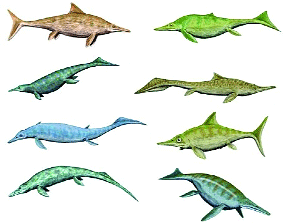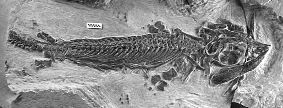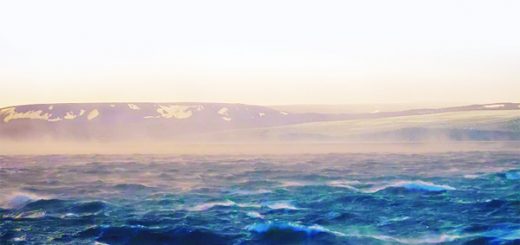The Real Sea Monsters
For millions of years, reptiles dominated the Earth. Many that dwelled on land were dinosaurs. But no dinos swam in the seas. The oceans had their own cadre of reptiles. Many were top predators, the sharks and killer whales of their time. And they would have made the oceans very dangerous.
Some of these marine reptiles were shaped like dolphins and probably could swim fast. Some were as large and as long as a school bus. But they lacked the distinctive hip structure that only dinos had.
A dinosaur had distinctive holes in its pelvis where its thighbones were attached, notes Sterling Nesbitt. He’s a vertebrate paleontologist at Virginia Tech in Blacksburg. Marine reptiles of the same time period lacked such holes.
About 252 million years ago, there was a mass extinction. At that time, huge volcanoes erupted in what is now Siberia. The ocean’s chemistry changed as well. As a result, large numbers of animals, plants and other species died out. Overall, about 90 percent of ocean species and 70 percent species on land disappeared. After the devastated ecosystems recovered, the few species that survived evolved to better fit in with the new environmental conditions.
With so many ocean species gone, some land creatures tried an aquatic lifestyle — and succeeded. These animals evolved to become ichthyosaurs (IK-thee-oh-saurs). Much later, after additional mass extinctions, other land-dwelling reptiles took to the seas. Their descendants evolved to become plesiosaurs, pliosaurs and mosasaurs.
People have been unearthing fossils of such sea creatures for hundreds of years. But scientists are still finding new species and discovering new information on what these animals looked like and how they lived.
Fish-lizards of the sea

Ichthyosaurs were among the earliest lizards to take to the seas. Their name even means “fish-lizard” in Greek. On the whole, ichthyosaurs were very successful. So far, paleontologists have discovered and named more than 100 different species of them, notes Benjamin Moon. He’s a vertebrate paleontologist at the University of Bristol in England.
Species from this group lived from about 248 million years ago to about 95 million years ago. Their fossils have been found worldwide. None of these came from rocks that started out as sediments from lakes or rivers, he notes. So ichthyosaurs all must have been ocean dwellers. Some of these aquatic reptiles were no more than 80 centimeters (about 31 inches) long. Others spanned a whopping 22 meters (72 feet). Some were very streamlined, like today’s dolphins. Others had more lizard-like proportions.
Some ichthyosaurs lived and foraged in coastal waters at the edge of continents. But others apparently swam in the open ocean, far from land. They even gave birth to live young at sea, like today’s whales and porpoises do. This is an example ofconvergent evolution, or the development of similar features in totally unrelated lineages. These similarities likely evolved from having to adapt to similar environments or places within an ecosystem.
Paleontologists had long suspected that some ichthyosaurs dove deep to find prey, like modern-day sperm whales. One of these animals was Ophthalmosaurus (Op-THAHL-moe-saur-us). With eyes up to 10 centimeters (4 inches) across, it takes its name — “eye lizard” — from the Greek. These 6-meter (nearly 20-foot) long creatures must have been chasing prey into very deep, dark waters, some scientists believe. Others have suggested those big eyes would have let the lizards hunt at night.
A recent study of some amazingly preserved fossils may help put an end to the debate. Scientists unearthed the fossils from rocks that are between 190 million and 196 million years old. Most fossils preserve just bone and other hard tissue. But these fossils included soft tissues that are probably skin.
Peppering the inside of that apparent skin were tiny blob-like structures. These measured between 500 and 800 nanometers long. That’s the same size as the pigment-carrying structures in skin cells and feathers of today’s mammals and birds, notes Johan Lindgren. He’s a vertebrate paleontologist at Lund University in Sweden. He and his colleagues now propose that the tiny blobs in this reptile are the remains of its pigment-carrying structures. Lindgren’s team described the findings in the February 27, 2014 issue of Nature.
The blobs were not flat, but ovoid. So the animal was probably black or dark brown, says Lindgren. His reasoning: That’s the color provided by ovoid melanosomes — the pigmented structure in cells — of modern-day animals. Perfectly round, or spherical, melanosomes usually carry a red or yellow color.
A deep-diving animal with a dark color over its entire body would be well camouflaged, Lindgren says. That would make it relatively easy to sneak up on prey. Today’s sperm whales, which hunt giant squid in deep waters, are dark gray all over, he notes. So, it’s very possible that the ancient ichthyosaur that he and his team studied was a deep-diver too.

Long-necked beasts

About 205 million years ago, a new type of marine reptile appeared in the seas. Scientists call them plesiosaurs (PLEEZ-see-oh-saurs), from the Greek words for “near to lizards.” The earliest of these resembled lizards, their presumed ancestors. But over time, the animals evolved to look very different.
Plesiosaurs typically had broad bodies, flippers and short tails. The most distinctive species also had long necks that made the animal look like a snake threaded through a turtle’s shell. And while most plesiosaurs had long necks, some had really long necks, notes Michael Everhart. He’s a vertebrate paleontologist at Fort Hays State University in Hays, Kansas.
These super-long-necked plesiosaurs belonged to a group called elasmosaurs (Ee-LAZ-moe-saurs). Their necks were so long that some of the first scientists to assemble their fossils couldn’t believe it, says Everhart. They mixed up the long neck and short tail, mistakenly putting the skull at the wrong end.
Recently, Everhart and his team took another look at fossils from a plesiosaur called Elasmosaurus platyurus. Dug up in Kansas during the late 1860s, these rocks were soon shipped East to a museum in Philadelphia. They’ve been there ever since.
The fossils that Everhart’s group surveyed are amazingly complete. They include a skull, which often is missing from plesiosaur specimens. Few skulls have survived because they are so delicate and relatively small — not much bigger around than the creature’s neck. Scientists have estimated that the creature was about 13 meters (42 feet) long when it was alive. And 7 meters (23 feet) of that length was nothing but neck!
Many teams have studied this specimen since it was first unearthed almost 150 years ago. But scientists are still in debates over the animal’s anatomy. For instance, they can’t decide how many neck bones it had.
When Everhart and his teammates looked at all the fossil pieces sitting on the museum’s shelves, they found an additional bone stored separately on a shelf nearby. It probably had been excavated at the same time. But it hadn’t been labelled by the people who dug it up. Still, it seemed to have come from the right type of rock and it had the same color and texture as the other fossils. It also was the right size and shape to be a part of a plesiosaur neck. So the researchers thought that perhaps the ancient jigsaw puzzle hadn’t been put together correctly. After further study, they proposed that this bone was indeed a new addition to the plesiosaur fossil.
If that’s right, then the beast had a whopping 72 bones in its neck. For comparison, almost all mammals — from mice to humans and giraffes — have only seven. Only one vertebrate now known had more neck bones than Elasmosaurus, says Everhart. That creature was also an elasmosaur. Its name is Albertonectes vanderveldei. It lived about 70 million years ago. Overall, it was slightly shorter than Elasmosaurus, but it had 76 neck bones.
Near the other extreme of neck proportions were marine reptiles called pliosaurs (PLY-oh-saurs). They emerged at around the same time as plesiosaurs. Even though they were related, evolution shaped them differently. Both groups both had broad, streamlined bodies. But pliosaurs had relatively short necks and massive heads. Because pliosaurs had large pointy teeth, scientists suggest they ate only meat. Their diet probably included fish, squid and other marine reptiles.

Similar shapes
Some 98 million years ago a fourth major group of marine reptiles emerged. The first fossils of these creatures were unearthed near the Meuse River in the Netherlands. The Latin name for that river is “Mosa,” hence the animals’ name: mosasaurs (MOE-sah-saurs). Their fossils have been found on every continent, so these animals had a global range. They died out about 66 million years ago, at the same time as the dinosaurs.
Mosasaurs started out small. One early species measured just 1 meter (3.3 feet) long, says Michael Polcyn. He’s a vertebrate paleontologist at Southern Methodist University in Dallas, Texas. But over time, he notes, some species became huge. The biggest spanned about 17 meters (56 feet).
Like pliosaurs, mosasaurs were top predators. So bigger species would have tackled really big prey. Fossils preserve some remnants of their last meals. That evidence shows that mosasaurs ate fish, squid, turtles, plesiosaurs and even other mosasaurs.
Fossils show that in some mosasaurs, the long tail makes an unusual turn downward, says Lindgren. That kink has long been a mystery. But in 2008, paleontologists found some very well-preserved mosasaur fossils that, for the first time, included soft tissue. Such ancient remains are giving scientists an idea of what the creature’s tail actually looked like. Lindgren and his team described the fossils in September 10, 2013 in Nature Communications.
Right above the point where the tail takes a turn downward, there’s an impression of a fleshy fin. That fin appears to have been covered with tiny scales. That’s expected for a reptile. But the shape of the fin is amazingly similar to the fleshy fins of some of today’s sharks. It’s also similar to the shape of the fins of some ichthyosaurs.
This is another example of convergent evolution. Mosasaurs, ichthyosaurs and sharks all lived in water and sometimes had to swim long distances. So, it was best for them to be as energy efficient as possible. For some species, that included being streamlined and having a long, crescent-shaped tail.
Where baby sea monsters come from
Scientists have long wondered how and where mosasaurs raised their young. Unlike with ichthyosaurs, few fetal remains have been found inside the bodies of adult mosasaurs, notes Daniel Field. He’s a vertebrate paleontologist at Yale University in New Haven, Conn. So perhaps adult mosasaurs laid eggs on land, like their distant, land-dwelling ancestors had. Or maybe they swam upstream into rivers, where young mosasaurs might have been better protected from ocean-going predators. There hasn’t been any strong evidence to support either notion, though, says Field.
In fact, there had been plenty of reason to think mosasaurs gave birth to their young at sea.
For one thing, he notes that mosasaurs were well-adapted to life at sea — not to life on land. Indeed, having a tail that bent downward at the end, rather than stretching out straight, would have made getting around on land pretty tough. Moreover, the pelvis in most mosasaurs wasn’t attached to the spinal column. That would have made it tough for the creatures to support their own weight or move efficiently when out of the water. But all these facts provided only circumstantial evidence for reproducing at sea, says Field. It was not strong proof, however.
Then, about a decade ago, researchers found fossils of young mosasaurs that had been buried in sediments far out at sea. The surface of those fossils showed signs of being eaten away by acid. It was as if the animals had been swallowed and partially digested. The bones had been either pooped out or thrown up. Then they had sunk and been preserved. That means that the young mosasaurs could have been eaten near shore and their remains carried out to sea inside whatever creature had eaten them.
But now, Field and his team have found fossils of young mosasaurs that hadn’t been etched by stomach acid. These fossils were entombed in rocks that had started out as seafloor sediment far from shore. So it’s likely these young mosasaurs had died at sea, says Field. It also seems likely they had been born there, he adds.
The fossils that Field’s team studied are tiny bits of jawbone. They include a few teeth. And the researchers didn’t go far to find them: They were stored at Yale’s museum, where they’d been sitting since soon after their discovery in the late 1800s. (This is yet another example of why collecting fossils, and keeping them for future study, is important.)
When paleontologists had first looked at the fossils, they assumed these were only bits from ancient seabirds. So they tucked away the bits in museum drawers. But new analyses show that the teeth were fastened into the jaws by a type of bony tissue that only mosasaurs had. Field and his colleagues described this discovery April 10 in Palaeontology.
After comparing the size of the tiny fossils with those of 3-meter-long adults presumed to be from the same species, the researchers now estimate the young mosasaurs were about 66 centimeters (26 inches) long.
“These are the first fossils from mosasaurs in this age bracket,” Field notes. They are also strong evidence for the notion that mosasaurs lived their entire lives in the open ocean.
The missing origin story
Unlike sharks and other fish, ancient marine reptiles were air breathers, like whales. That’s because ichthyosaurs, mosasaurs and other ocean-going reptiles had evolved from creatures that once lived on land.
For a long time, though, paleontologists had no idea of what the land-dwelling ancestors of these species might look like. That’s because there was a big gap in the fossil record before the first ichthyosaurs, says Moon in Bristol, England. That hole in time was millions of years long, he adds. It was so long that once the ichthyosaurs were discovered, even the earliest known individuals already were well adapted to life at sea.
Then, in 2011, a team unearthed an interesting fossil in eastern China. It was nearly complete and lacked only a part of its tail. The ribs and vertebrae had thick walls containing lots of bone. So the creature was probably an adult when it died, says Da-Yong Jiang. He’s a vertebrate paleontologist at Peking University in China. But most bones in the fossil’s forelimbs were small and widely separated. That’s a sign that the forelimbs were probably cartilage-filled flippers and not legs, he explains.
The hind limbs also were smaller than would be expected for something that lived on land. That would have been another adaptation for swimming. The limbs probably weren’t used for propulsion, Jiang says. Nevertheless, the reptile could probably get around on land, just as today’s seals and sea lions can.
When alive, the creature was probably about 40 centimeters (16 inches) long and weighed about 2 kilograms (4.4 pounds). It is now the smallest known ichthyosaur. Scientists named it Cartorhynchus lenticarpus (CAR-toe-RING-kuss LEN-tee-CAR-pus). That comes from the Greek words for “shortened snout” (another feature of this fossil) and the Latin words for “flexible wrist.”
This creature “is the closest thing we have to a terrestrial ancestor of ichthyosaurs,” says Valentin Fischer. He’s a vertebrate paleontologist at the University of Liège in Belgium. He was not part of Jiang’s team.
The new find also suggests that even earlier ancestors of ichthyosaurs might be discovered one day. Unearthing those species might help scientists solve the mystery of which land creatures gave rise to these sea monsters of our distant past. n
















Recent Comments